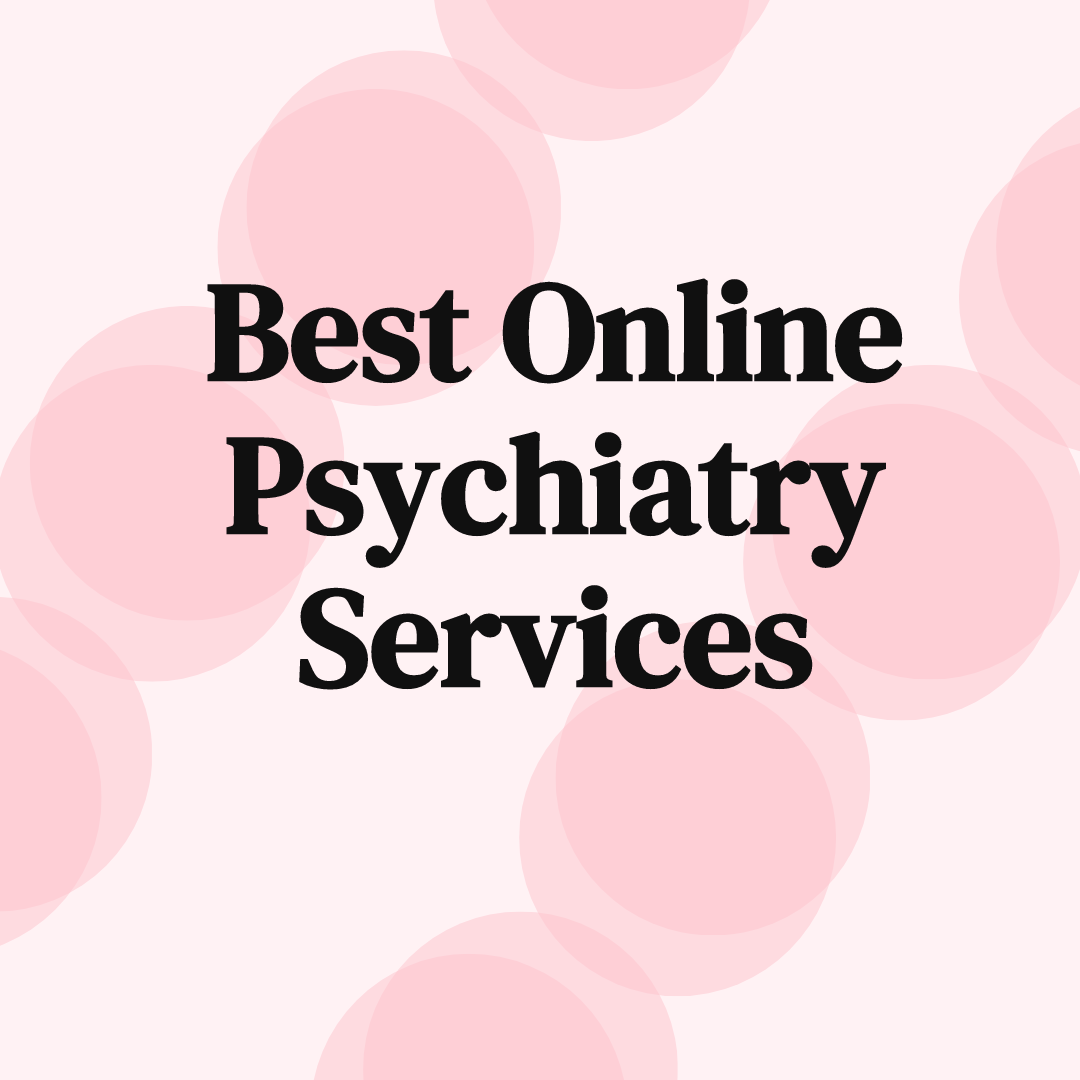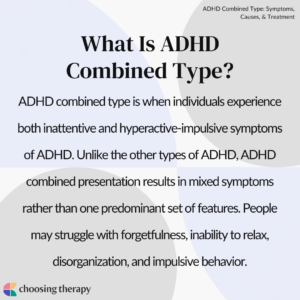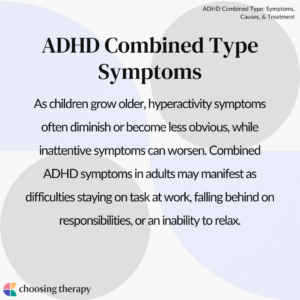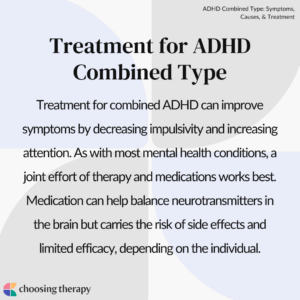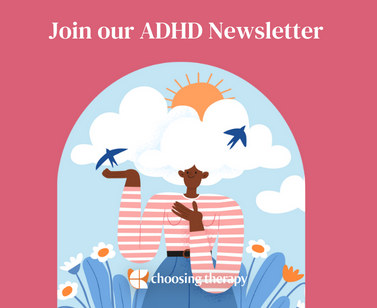Combined type ADHD results in patterns of inattention and hyperactivity or impulsivity that interfere with daily functioning. Those with ADHD-C may struggle with a mix of distractibility, forgetfulness, constant fidgeting, and restlessness. As with other types of ADHD, treatment for combined ADHD presentation may include medication, behavioral therapy, psychoeducation, and lifestyle changes.1
Online Psychiatry For ADHD Covered By Insurance
Talkiatry can match you with a real psychiatrist who takes your insurance and is seeing new patients. They’re in-network with major insurers and offer medication management. Get started with a short online assessment
What Is ADHD Combined Type?
ADHD combined type (ADHD-C) is when individuals experience both inattentive and hyperactive-impulsive symptoms of ADHD. Unlike the other types of ADHD, ADHD combined presentation results in mixed symptoms rather than one predominant set of features. People may struggle with forgetfulness, inability to relax, disorganization, and impulsive behavior.2
How Common Is ADHD Combined Type?
Recent data suggests that combined ADHD presentation is the most common type of ADHD, with a higher prevalence in men.3,4,5,6 While inattentive ADHD often predicts academic problems and peer neglect, hyperactive-impulsive ADHD can increase aggression and peer rejection. In the case of ADHD-C, inattention typically appears later in life, so parents and caregivers may notice hyperactivity-impulsivity in children first.7
Combined ADHD Type Vs. Other Types
Combined ADHD differs from the other types in that the diagnosis incorporates both sets of symptoms. Because of this mix, combined ADHD is more easily recognized. Historically, the differences between presentations were in severity rather than type of symptoms, with more severe cases being combined types. Today, ADHD-C does not equate to increased severity.
ADHD Combined Type Symptoms
Symptoms of combined type ADHD vary from one person to the next, and presentation can change over time. As children grow older, hyperactivity symptoms often diminish or become less obvious, while inattentive symptoms can worsen.7 Combined ADHD symptoms in adults may manifest as difficulties staying on task at work, falling behind on responsibilities, or an inability to relax.
Common combined type ADHD symptoms include:
Inattentive symptoms
- Struggling to follow instructions
- Inability to persist at tasks or play activities
- Difficulty remembering rules
- Trouble following instructions
- Ineffectively resisting distractions
- Difficulty planning
- Disorganization
- Forgetfulness
- Being slower and less likely to return to an activity once interrupted
Hyperactive-impulsive symptoms
- Fidgeting or squirming
- Difficulty staying seated
- Talking excessively
- Interrupting others’ activities
- Difficulty waiting for one’s turn
- Less able to delay gratification
- Running or climbing at inappropriate times
- Unable to participate quietly in leisure activities
Is Combined ADHD Type More Severe?
Combined ADHD type is not inherently more severe than other presentations. The intensity of ADHD is distinct from the number and type of symptoms you experience. Whether your symptoms are mild, moderate, or severe will have more impact on functioning.
Get Help For ADHD
Talkiatry can match you with a real psychiatrist who takes your insurance and is seeing new patients. They’re in-network with major insurers and offer medication management. Get started with a short online assessment
Inflow App – Inflow is the #1 science-based app to help you manage your ADHD. Their support system helps you understand your neurodiverse brain, and build lifelong skills. Free Trial
What Causes ADHD Combined Type?
The direct cause of combined ADHD is not determined, but experts agree the relationship between nature and nurture is likely at play. Evidence suggests a two- to fourfold increased risk of developing ADHD among first-degree relatives, although the specific subtype is not specified.7 Sociological factors, like life transitions, quality of schooling, and family stress, may also contribute to the combined subtype of ADHD.
Possible causes of combined ADHD include:7
- Cigarette smoking and/or alcohol use during pregnancy
- Premature delivery or other pregnancy complications
- Pesticide exposures during pregnancy
- Maternal weight, health, and nutrition
- Low birth weight
- Low socioeconomic status
How Is Combined ADHD Diagnosed?
A typical diagnostic process for combined type ADHD includes an initial screening evaluation, an in-depth interview, rating scales, and occasional observation in a natural setting. Depending on the age at diagnosis, professionals may also review school records. Evaluations do not require preparation unless a physician requests additional documentation.
A psychiatrist, psychologist, or primary care physician can diagnose ADHD combined type. To receive a diagnosis, at least six symptoms of both inattentive and hyperactive types, for a total of twelve or more, must be present for at least six months. Symptoms may present differently for a child than an adult but must have begun before age twelve.
A diagnostic process for ADHD combined type may include:8
- Medical history review
- Psychological tests
- Parent and teacher reports
- Observation in your natural environment
- Family history review
Online Psychiatry For ADHD Covered By Insurance
Talkiatry can match you with a real psychiatrist who takes your insurance and is seeing new patients. They’re in-network with major insurers and offer medication management. Get started with a short online assessment
Treatment for ADHD Combined Type
Treatment for combined ADHD can improve symptoms by decreasing impulsivity and increasing attention. As with most mental health conditions, a joint effort of therapy and medications works best. Medication can help balance neurotransmitters in the brain but carries the risk of side effects and limited efficacy, depending on the individual.
Treatment for Children & Adolescents
Both medication and therapy techniques can improve ADHD combined type in children. A comprehensive treatment plan will include suggestions for multiple settings, including home, school, and extracurricular social activities. Mental health professionals will review particular symptoms to determine which approaches best suit the child’s needs. Treatment often targets issues in school, such as difficulty following directions and trouble sitting still during lessons.
Treatment for combined ADHD in children and teens may include:8
- Behavioral therapy: Behavioral therapy, including CBT for ADHD, involves teaching, practicing, monitoring, and reinforcing skills to enhance attention and motivation. Successful treatment for children and teens requires the cooperation of parents and teachers.
- Parent management training: This approach teaches parents to reduce stress when learning to parent a child with ADHD. Parent management training educates parents about ADHD, encourages them to model socially competent behavior, and provides consistent rewards and consequences.
- Medication: Stimulant or non-stimulant medications may help improve symptoms of inattention and hyperactivity. However, ADHD medications come with the risk of side effects, so consult your child’s pediatrician to learn the pros and cons.
- School-based interventions: Many children with combined type ADHD benefit from a team approach that includes their teacher and school counselor. A teacher implementing classroom management approaches with a child can promote increased attention span and motivation for socially positive behaviors.
- Executive skills training: Many children with combined ADHD experience executive dysfunction. Focus on improving specific executive functions can increase their emotional regulation, resilience, sustained attention, ability to think before acting, persistence, organization, time management, and more.9
Treatment for Adults
ADHD combined type in adults is treated similarly to children and adolescents but with more focus on individual and work-based skills. Symptoms will help determine the specific goals of their treatment plan, with a combination of medication and behavioral therapy being the most effective. Medication alone does not lead to long-term positive outcomes, whereas behavioral therapy can help to sustain symptom management.10
Treatment for ADHD combined type in adults may include:
- Behavioral therapy: Behavioral therapy interventions focus on practical domains, which can lead to long-term benefits in daily life. These techniques for combined type ADHD can improve both inattentive and hyperactive-impulsive symptoms.10
- Medication: As with children, prescription medication for adult ADHD could include stimulants or non-stimulants. A thorough discussion with a doctor can help individuals stay informed about their pharmaceutical treatment.
- Social skills training: Learning behaviors to improve interpersonal relationships, such as maintaining personal space, starting and continuing a conversation, and setting boundaries, can address some impacts of combined presentation ADHD symptoms.8
- Natural remedies: Natural remedies for ADHD can improve ADHD symptoms without the adverse effects that can occur with prescription medication.
- Mindfulness: Research has shown mindfulness training can improve attention and self-regulation, two factors in treating ADHD combined presentation.11
- Adaptive technology: Leveraging technology, such as calendar and task management apps, can assist with organization and time management.
- Work accommodations: Consider collaborating with employers to implement reasonable accommodations, such as flexible work hours, regular check-ins, and assistive devices (i.e., noise-canceling headphones).
- Healthy sleep schedule: Chronic sleep deprivation can exacerbate symptoms of ADHD. Improving the quality and duration of sleep can lead to a significant reduction in symptoms.12
How to Find Professional Support for ADHD
When finding a neurodiverse-affirming therapist, look for providers specializing in ADHD combined type. You may want to search an online therapist directory or try an online therapy platform to find a therapist offering ADHD treatment. Consider seeing a psychiatrist if you want to learn more about medication options. Like with therapy, online psychiatrist options are available if you prefer at-home care.
In My Experience
Additional Resources
To help our readers take the next step in their mental health journey, Choosing Therapy has partnered with leaders in mental health and wellness. Choosing Therapy is compensated for marketing by the companies included below.
ADHD Management Tools
Inflow App Inflow is the #1 science-based app to help you manage your ADHD. Their support system helps you understand your neurodiverse brain, and build lifelong skills. Free Trial
Online Psychiatry
Circle Medical – ADHD Diagnosis and Treatment. Affordable and accessible ADHD evaluations and treatment, including possible controlled substances medication if clinically appropriate. Diagnosis and prescription over video. Insurance accepted. Same & next day appointments available. Visit Circle Medical
Online Therapy
BetterHelp Get support and guidance from a licensed therapist. BetterHelp has over 20,000 therapists who provide convenient and affordable online therapy. Take A Free Online Assessment and get matched with the right therapist for you. Free Assessment
Free ADHD Newsletter
A free newsletter from Choosing Therapy for those impacted by ADHD. Get helpful tips and the latest information. Sign Up
Choosing Therapy Directory
You can search for therapists by specialty, experience, insurance, or price, and location. Find a therapist today
Do you think you have ADHD? Answer an evidence-based questionnaire for Circles Medical to learn more. Takes 45 seconds.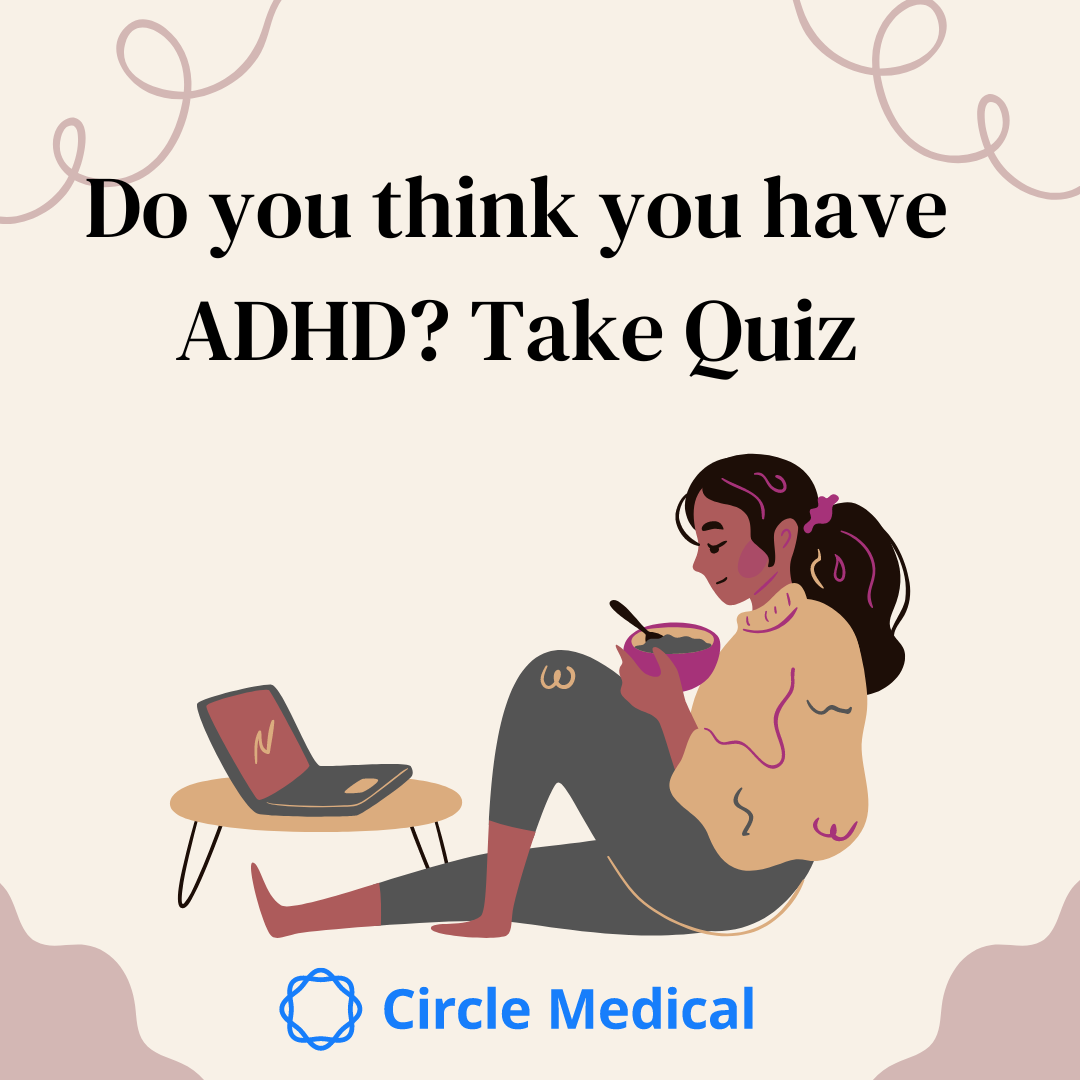
Best Online Psychiatry Services Online psychiatry, sometimes called telepsychiatry, platforms offer medication management by phone, video, or secure messaging for a variety of mental health conditions. In some cases, online psychiatry may be more affordable than seeing an in-person provider. Mental health treatment has expanded to include many online psychiatry and therapy services. With so many choices, it can feel overwhelming to find the one that is right for you.